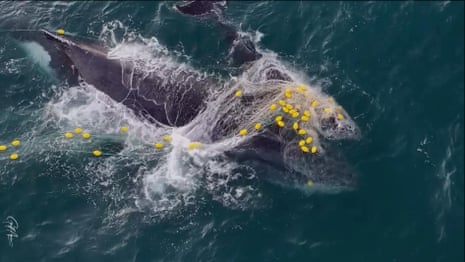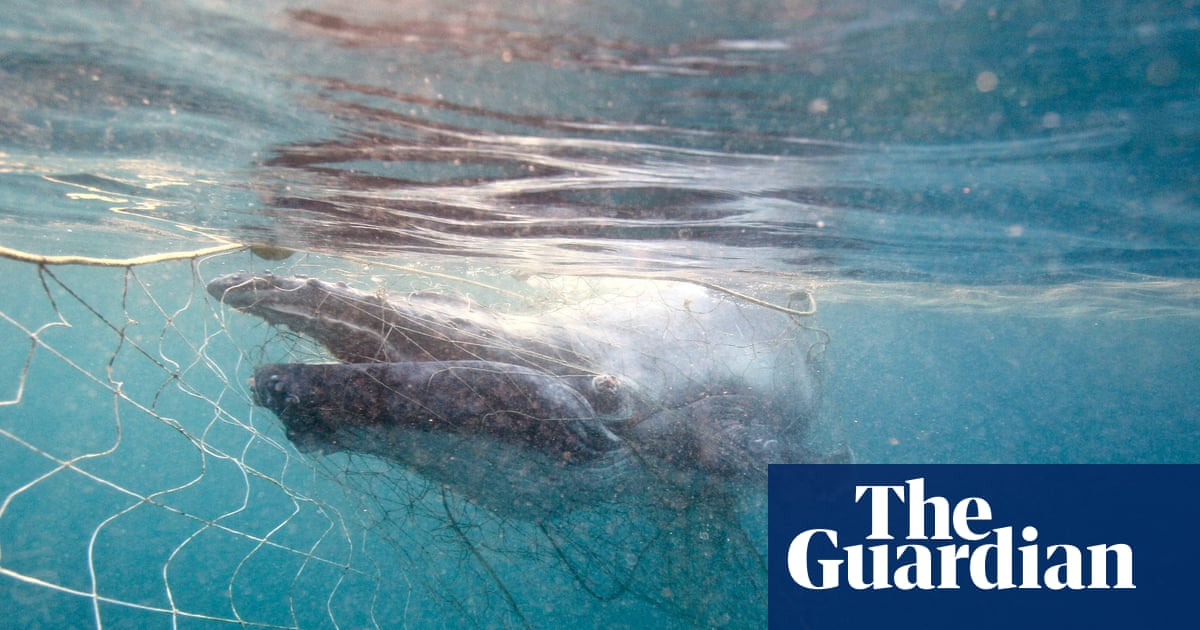Scientists say a flourishing whale population that is swimming closer to shore and into the path of shark nets is contributing to the 50% increase in entanglements off Queensland’s coast this year.
Nine entanglements involving 12 whales have already occurred this year, compared with six on average, many off the Sunshine Coast. Eight whales were tangled in shark nets in 2024.
Prof Rob Harcourt, a marine ecologist at Macquarie University, said late September and early October was “peak whale” on the east coast as humpbacks made their southerly migration towards their Antarctic feeding grounds.
While whale entanglements in nets were “horrible”, Harcourt said the higher number this year likely reflected the growing humpback population, as well as the position of an ocean current bringing them closer to shore.
The recovery of humpback whales – with numbers reaching 50,000 this year – had been a success story, he said.
 Humpback whale and calf caught in shark net off Noosa – video
Humpback whale and calf caught in shark net off Noosa – video
“With that increasing population, you have a lot more bubs born” – and more that could get caught in shark nets.
The location of the east Australian current – a strong ocean current running north-to-south along Australia’s east coast – was likely a contributing factor, he said.
A University of Sunshine Coast study in 2020 found entanglements in shark nets were more likely to occur when the inner edge of that current shifted closer to the shore.
Sign up: AU Breaking News email
The study’s lead author, Dr Jessica Bolin, said the current’s inner edge formed a large thermal front – a boundary between warm and cool water – which whales may use as a natural navigation cue during their migrations.
“The [east Australian current] is a warm, powerful and highly dynamic ocean current that changes position from day to day,” she said. “When that front hugs the coastline, humpbacks may be following it inshore, which unfortunately also raises their chances of encountering shark nets.
“The Sunshine Coast is also a pinch point on their migration route, with multiple shark nets placed right across that corridor,” she said.
In the worst case, entanglements could cause drowning, Harcourt said. But even minor incidents could have long-term effects on the animal due to the high levels of stress.
“The only way to stop entanglement, really, is to take the nets out,” he said.
Other approaches such as acoustic deterrents had been trialled but were ineffective, he said.
On Sunday, Queensland’s premier, David Crisafulli, said the state was “not for turning” on its plan to expand shark netting after reports of another mother and calf trapped off Rainbow Beach. He said the state would not put protecting whales “at the expense of one single human”.
The total number of whales affected each year in Queensland fluctuated between 1 and 15 (in 2022), according to QFish data. QFish is part of the state’s Department of Agriculture and Fisheries.
Twelve whales had been affected so far in the 2025 migration season, which has four weeks still to go.
A spokesperson for Queensland’s Department of Primary Industries said all whales caught in nets had been released “safely and alive”.
Dr Olaf Meynecke, who researches marine mammals at Griffith University, said the majority of entanglements used to occur near the Gold Coast but have shifted towards the Sunshine Coast since 2020.
Most involved mothers and calves, he said. “We’ve got higher calving rates, and that increases entanglements.”
A spokesperson for the NSW Department of Primary Industries said its 51 shark nets were fitted with acoustic “whale alarms” and “dolphin pingers” designed to deter marine mammals away from the nets.
Smart drumlines are designed to break apart if a whale swims through them, which occurred in 22 cases this year. However in June a whale became tangled in one off Nobby’s beach in Newcastle.
A federal environment department spokesperson said humpback whales were listed as a migratory species and protected under federal environment laws.
“However, as shark nets and subsequent cetacean entanglements occur within state and territory jurisdictions, incident response activities are a responsibility of the relevant state or territory government.”
